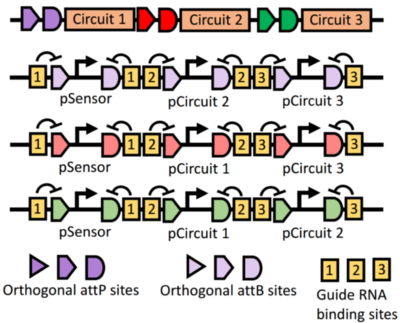Field-Programmable, Recombinase-Based Biomolecular Circuits
From Murray Wiki
This project funded by the Army's Institute for Collaborative Biotechnology, an Army University Affiliated Research Center (UARC)
|
Current participants: Additional participants: |
Collaborators: Past participants:
|
Objectives

This project explores the use of recombinases -- integrases, excisionases, and other methods of manipulating DNA -- as platform for engineering biomolecular circuits. Our high-level goal is to develop a design-oriented framework for recombinase-based, genetically-encoded circuits that can be used for detection, diagnostics, and logging of environmental signals and events. The specific objectives this project are to:
- Develop circuit components, mathematical models, experimental protocols, and system characterization methods that enable recombinase-based circuits to be designed and utilized in a systematic fashion.
- Implement a set of biological “event detectors” in both cell-free and cell-based assays, and demonstrate their utility in applications that combine digital, analog, and stochastic operations.
References
- Addressable and adaptable intercellular communication via DNA messaging. John P. Marken and Richard M. Murray. Nature Communications, 14:2358, 2023.
- Integrase-mediated differentiation circuits improve evolutionary stability of burdensome and toxic functions in E. coli. Rory L. Williams and Richard M. Murray. Nature Communications, 13:6822, 2022.
- Tunable integrase-mediated differentiation facilitates improved output of burdensome functions in E. coli. Rory L. Williams, Richard M. Murray. bioRxiv 614529, 2019 (revised 2020, 2022).
- Addressable, “Packet-Based” Intercellular Communication through Plasmid Conjugation. John P. Marken, Richard M. Murray. qBio 2019 Conference.
- Proof of concept continuous event logging in living cells. Andrey Shur, Richard M. Murray. 2019 Synthetic Biology: Engineering, Evolution and Design (SEED) Conference.
|
|
|